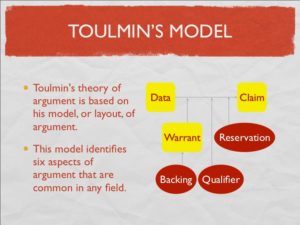In their article, “Articulating Claims and Presenting Evidence: A Study of Twelve Student Writers, From First-Year Composition to Writing Across the Curriculum,” J. Paul Johnson and Ethan Krase share their longitudinal study in which they examined transfer as a key component of argumentation from first-year composition (FYC) to writing across the curriculum (WAC) in the junior and senior years of college. After highlighting several studies that have also analyzed transfer of argument skills (Rose, 1989; Dias et al., 1999Smit, 2004; Thaiss and Zawacki, 2006; Wardle, 2007; Greene & Orr, 2007; Fukuzawa & Boyd, 2008), Johnson and Krase align themselves with Toulmin’s method of argument, noting that “Toulmin’s taxonomy of argument allows for accommodation of the generic features of argument, primarily its use of claims and evidence, across multiple disciplinary areas” (p. 33). They define claim as “the main point a writer hopes to assert,” which is supported by evidence, or what Toulmin called data (p. 32).

Using these definitions, the authors conducted their study seeking to answer the following questions: “Did students employ claims in their writing in FYC and WAC? Were students’ claims clear, concise and qualified? Did students support claims with authoritative, varied, and documented evidence? As students progressed through and beyond FYC to WAC in their various undergraduate majors, did their abilities to employ claims and evidence improve?” (Johnson & Krase, 2013, p. 33).
Twelve students participated in the study, and in order to examine more closely “individual students’ transition from FYC to their later WAC coursework, [the authors] collected and triangulated data from multiple sources and at various stages of development” (p. 33). Data from each student portfolio allowed the authors to examine students writing at three specific points: 1.) the start of first-year composition, 2.) the end of first-year composition, and 3.) during writing across the curriculum.
 The authors note that the evidence from their study suggests that the majority of the twelve students improved their ability to articulate claims and support them with evidence in FYC. In the WAC courses, the authors found that “[w]hile the students in this study encountered in WAC a diverse variety of genres, most of those genres required them to support claims with evidence. In this regard, students appeared to benefit from related instruction in FYC. That is to say, students’ development of ability to articulate and support claims in FYC appeared directly related to their ability to do so in their later WAC courses” (p. 46). But after reading this article, I have several questions for the authors about their methodology in this study. Were FYC instructors teaching with transfer—or WAC at the very least—in mind? While enrolled in WAC, were students prompted to recall the skills learned in FYC? To what extent were the students responsible for their own transfer?
The authors note that the evidence from their study suggests that the majority of the twelve students improved their ability to articulate claims and support them with evidence in FYC. In the WAC courses, the authors found that “[w]hile the students in this study encountered in WAC a diverse variety of genres, most of those genres required them to support claims with evidence. In this regard, students appeared to benefit from related instruction in FYC. That is to say, students’ development of ability to articulate and support claims in FYC appeared directly related to their ability to do so in their later WAC courses” (p. 46). But after reading this article, I have several questions for the authors about their methodology in this study. Were FYC instructors teaching with transfer—or WAC at the very least—in mind? While enrolled in WAC, were students prompted to recall the skills learned in FYC? To what extent were the students responsible for their own transfer?
These methodology questions beg some larger questions for me regarding WAC and transfer: How is transfer taught for in a WAC curriculum? To what extent is the onus left on the students to transfer writing skills across contexts? Do FYC instructors encourage students to think beyond FYC? Or do WAC instructors prompt students to recall what they learned in FYC?
Johnson, J.P. and Krase, E. (2012). Articulating Claims and Presenting Evidence: A Study of twelve student writers, from first-year composition to writing across the curriculum. The WAC Journal 23, 31-48.
